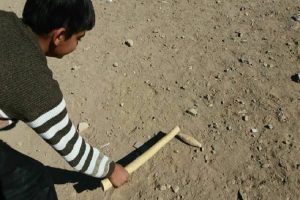The works from the Achaemenid era, are scattered in the museums of Europe and the private collections of westerners, are so outstanding in their make and beauty that they are considered an invaluable part of the ancient heritage of Iran and the world. A surviving work of Achaemenid art is “Mountain Goat Vase,” A beautiful, imaginative, and brilliant work that alone speaks of the mastery and precision of the artists of that period and is a precious souvenir of the vast Achaemenid Empire. This work is kept in the Louvre Museum in Paris.
This brilliant mountain goat vase is made of antique silver with gold plating. What adds to the beauty of this piece is the goat who is landing on a human mask that has a mythical face. This figure is a combination of a human face and a jumping figure of an animal, and it is the peak of the mastery of the artist who created it. The animal’s head is beautifully turned towards the viewer, and its horns are made with praiseworthy elegance. The animal’s body is slim, and its two wings show the imaginary face of the work. Mountain goat vases are made using the casting method. Its height is 27 cm, and its length is 15 cm.
The wings and horns of this mountain goat have been considered a sign and symbol of vitality and strength, and the face of the mythical creature on which the animal’s hooves are placed is called “Silnus.” Silenus means a mixed creature of human and goat and is considered the symbol (or God) of wine and drink. Apart from this, the details used in constructing this animal-human body are unique, conveying the message of vitality and life force to the viewer. This leaping animal was believed to be the handle of a vase (or pot) for wine. Perhaps a symmetrical mountain goat was built on the other side of the vase, which has now disappeared. The golden coating of the work has given it a double beauty and made it shine more.
The mountain goat vase was made in the 4th century BC and was discovered in the palace of Darius I in Susa. This work, kept in the Louvre Museum, has another example in the Museum of Ancient Iran in Tehran.
The symbol of the mountain goat is often seen in the ancient and prehistoric artworks of Iran and Mesopotamia. This animal was painted or made with long and semicircular horns. The horn of the goat had a mythological connection with the moon and reflected an abstract meaning. Such a symbolic animal has been seen in the oldest bodies found in Iran. Examples of it have even been found in the Neolithic period, and it is known as one of the most ancient symbols and figures of Eastern civilization. Perhaps guarding the animal from the water is one of the symbols of such figures. In Achaemenid art, the symbol of a mountain goat and a ram is often seen to adorn the tools made. So, the goat with big horns can be seen as a recurring symbol in Achaemenid art.
The mountain goat vase is a beautiful, symbolic, precious souvenir of Achaemenid art. It is considered one of the most important works of the Louvre in the Iranian section of that museum, where the civilizational works of Iran can be found in abundance.










